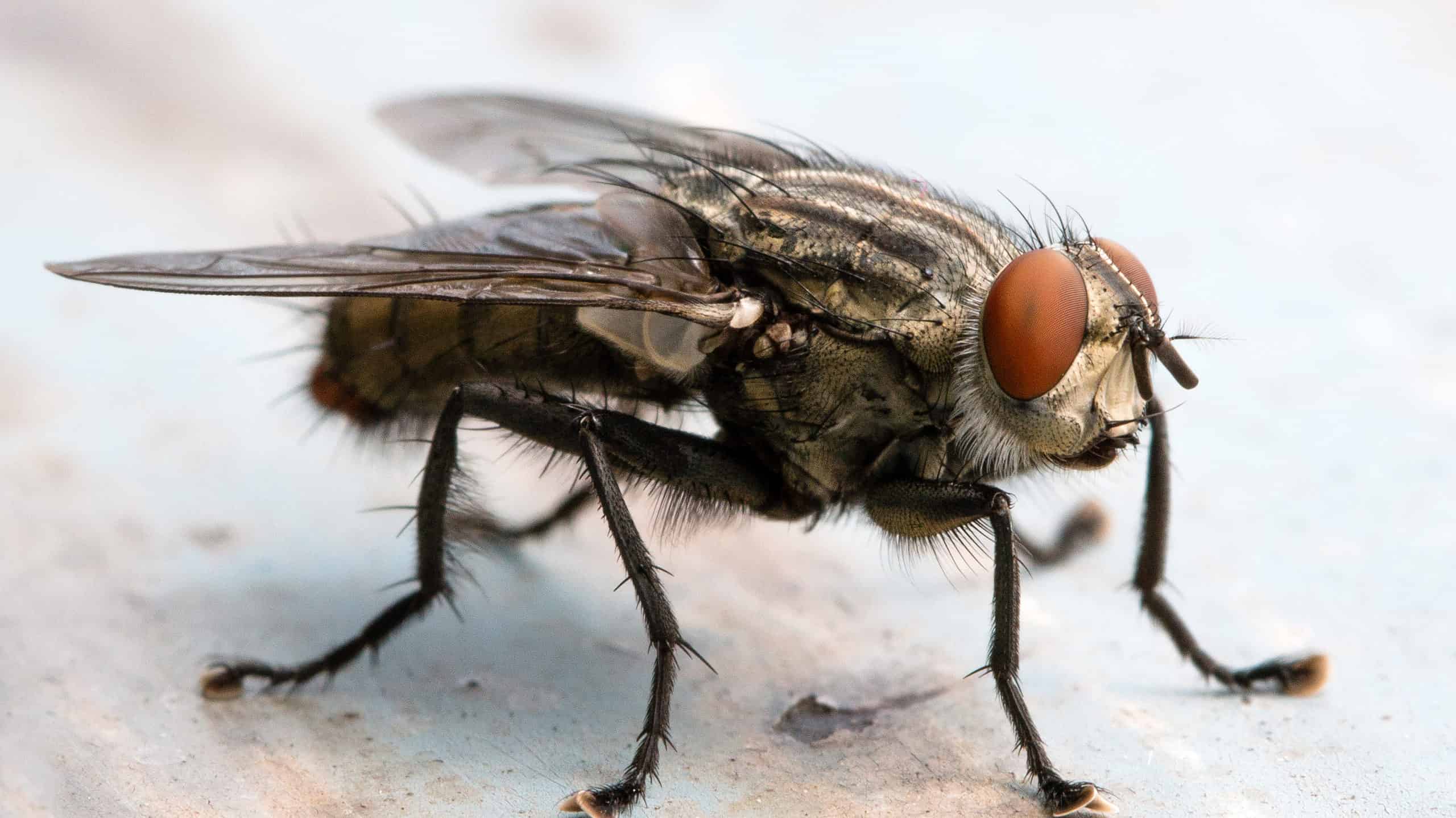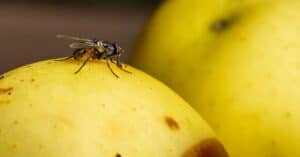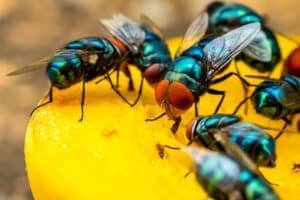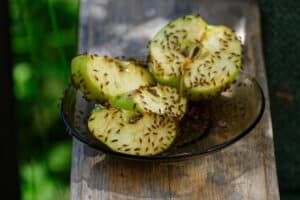House flies are a persistent nuisance in our homes, buzzing around and landing on everything from our food to our faces. Beyond their annoyance, these unwelcome visitors also bring health risks and have the potential to carry disease-causing bacteria. Fortunately, you don’t have to resort to chemical pesticides to get rid of them. Discover natural and effective ways to remove house flies from your living space. Explore eco-friendly methods that are safe for your family and pets, and say goodbye to the constant hum of house flies.
1. Homemade Fly Traps
House flies are relentless, but several natural and cost-effective methods exist to eliminate them from your living space. For instance, you can craft homemade fly traps using everyday household and pantry items. These traps attract and capture flies, reducing their numbers and providing you with a fly-free home.
To make your homemade fly traps, you can choose from various DIY options. One common and effective trap involves a mixture of apple cider vinegar and a few drops of dish soap. The vinegar’s sweet scent attracts flies, while the dish soap breaks the surface tension, causing flies to drown.
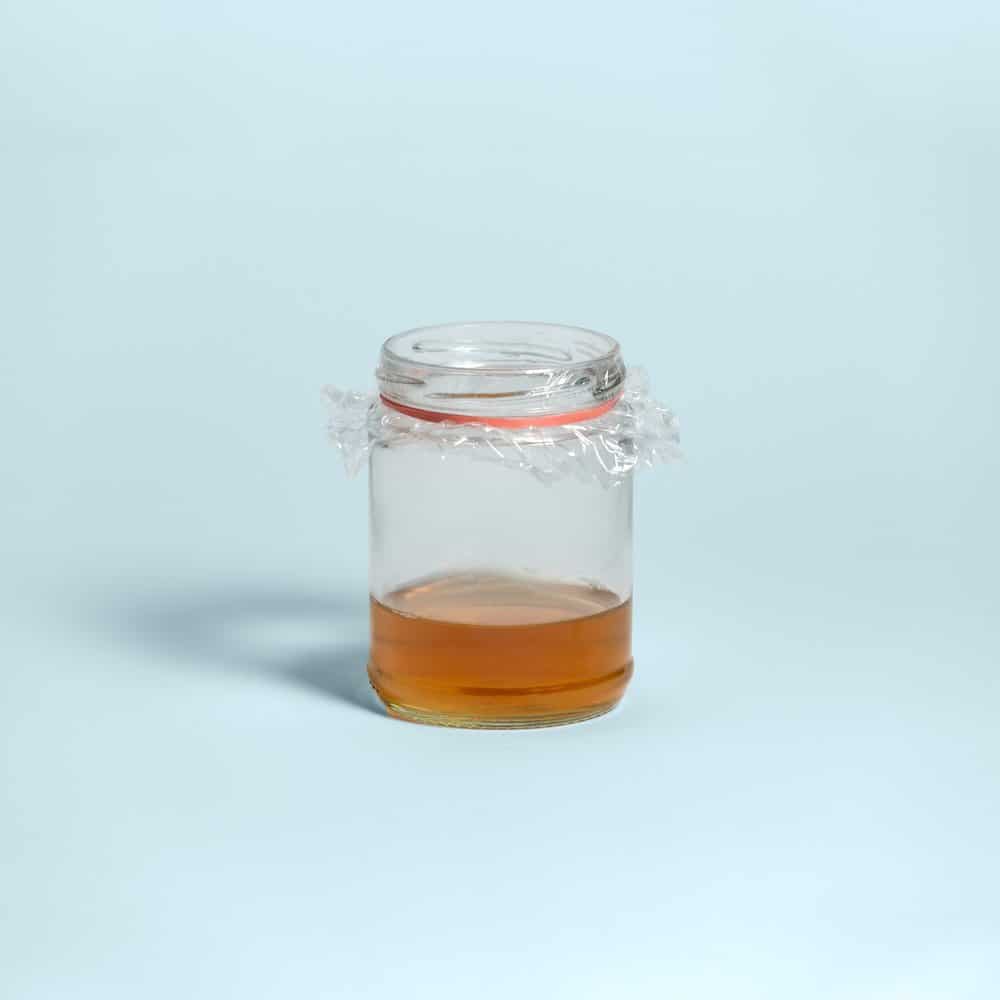
Apple cider vinegar with a drop of dish soap creates a captivating scent for flies while ensuring they meet a soapy demise in the trap.
©Jeremy da Silva/Shutterstock.com
Apple Cider Vinegar and Dish Soap
To create this trap, follow these simple steps:
- Take a shallow dish or bowl and fill it with apple cider vinegar, leaving about an inch of liquid at the bottom.
- Add a few drops of dish soap to the vinegar and gently mix it. The dish soap will ensure that flies sink into the liquid.
- Cover the dish with plastic wrap and secure it with a rubber band. To attract flies, poke small holes in the plastic wrap.
- Place these homemade fly traps in areas where flies are most bothersome, such as near garbage cans or in the kitchen.
Ripe Fruit
You can create another effective homemade trap from a piece of ripe fruit, such as a banana or a slice of melon. Flies are naturally drawn to these fruits, making them an excellent bait. To create this trap:
- Simply place a piece of fruit in a container and cover it with plastic wrap, securing it with a rubber band.
- Poke holes in the plastic wrap to allow flies to enter but prevent their escape. When the trap is filled with flies, dispose of it properly.
Sugar and Baking Soda Trap
Creating a sugar and baking soda trap is another straightforward and effective method for getting rid of house flies. Follow a few steps:
- Take a shallow dish or bowl and add equal parts sugar and baking soda.
- Add enough warm water to create a thick, sugary paste.
- Place the dish with the sugar and baking soda mixture in an area where flies are active.
Pro tip: Homemade fly traps are particularly useful when dealing with a small to moderate number of flies. However, for larger infestations, you may need to combine these traps with other natural methods, such as essential oils or herbs, for more comprehensive fly control.
2. Essential Oils
When it comes to getting rid of house flies naturally, essential oils offer a powerful solution. These concentrated plant extracts not only emit pleasant aromas but also serve as effective fly repellents. If you’re looking for a chemical-free and eco-friendly way to keep flies at bay, essential oils are a popular and safe choice.
Several essential oils offer potent fly-repelling properties, including:
- Lavender oil: The sweet and calming scent of lavender is well-loved by humans but detested by flies.
- Eucalyptus oil: Eucalyptus oil carries a refreshing, minty scent that can deter flies and other insects. It is especially useful in keeping your living space bug-free.
- Peppermint oil: The strong and invigorating aroma of peppermint is excellent for driving away flies. Additionally, apply peppermint oil indoors and outdoors to create a fly-free landscape.
How to Use Essential Oils to Repel House Flies
There are various ways to harness the power of essential oils to keep flies out of your home:
- Sprays: Create a fly-repellent spray by mixing a few drops of essential oil with water. Shake well and then spritz the solution in fly-prone areas like doorways, windows, and kitchen counters. The aroma will deter flies from entering your home.
- Cotton balls: Apply a few drops of essential oil to cotton balls and place them strategically around your home.
- Diffusers: Essential oil diffusers are a convenient way to disperse the aroma of your chosen oil throughout your living space. Set up a diffuser in a fly-prone room for continuous fly control.
- Potpourri: Combine dried herbs, such as lavender or mint, with a few drops of essential oil to create homemade potpourri. Place this mixture in bowls in various rooms to ward off flies.
- DIY candles: You can create your own fly-repelling candles by mixing essential oils with melted wax. These candles not only provide a soothing ambiance but also keep flies away.
Essential oils are a safe and natural way to repel flies without using harmful chemicals. They are especially effective for smaller infestations or for creating a fly-repelling atmosphere in specific areas.

Essential oils are effective against flies and have been used for centuries in aromatherapy to promote relaxation and well-being.
©Halil ibrahim mescioglu/Shutterstock.com
3. Citronella Candles
Citronella candles are a popular and effective natural solution for keeping house flies and other flying insects at bay. Though typically used outdoors, the pleasant aroma of citronella, a fragrant oil derived from lemongrass, adds a refreshing scent and also acts as a powerful fly repellent that keeps the pests from entering your home.
Citronella is a natural essential oil known for its strong, lemony scent that masks the odors that attract flies and disrupts their ability to locate potential hosts. Place citronella candles on your patio, deck, or any outdoor area where you want to enjoy fly-free moments. Additionally, the candles work best in areas with minimal wind.
You can also use citronella candles as table centerpieces during outdoor gatherings. They are a popular choice for those seeking a natural and pleasant way to repel flies outdoors and keep the pests from entering your home in the first place. However, their effectiveness may vary depending on factors like the concentration of citronella in the candle and wind conditions.

Citronella candles were originally used as mosquito repellents. They gained popularity in the 20th century for creating bug-free outdoor gatherings.
©Ana Belen Garcia Sanchez/Shutterstock.com
4. Herbs
Humans have been using herbs for centuries not only to add flavor to food but also to repel insects, including house flies. These aromatic plants contain essential oils that are known for their ability to deter flies and other pests. Several herbs are effective in repelling flies due to their strong scents and natural properties, including:
- Basil: Basil emits a strong, pleasant aroma that naturally deters flies. It is not only a great addition to your kitchen but also a useful fly repellent when grown near windows and doors.
- Mint: Plant mint in pots or in your garden to keep flies at bay with its refreshing scent. The aroma is both soothing to humans and unpleasant for flies.
- Rosemary: Rosemary is another versatile herb that adds flavor to dishes and serves as a natural fly deterrent. Plant rosemary near entry points to discourage flies from entering your home.
- Lavender: Lavender’s sweet and calming scent is loved by people but disliked by flies. Plant lavender in your garden or keep pots of it near windows to prevent flies from coming inside.
How to Use Herbs to Control House Flies
Here are various ways to use fly-repelling herbs in your home:
- Herb garden: Cultivate herbs in your garden or in pots on your windowsill to create a natural barrier against flies.
- Sachets: Create sachets filled with dried herbs and hang them in areas where flies are a problem, such as near doors and windows. The scent will discourage flies from entering your home.
- Potpourri: Combine dried fly-repelling herbs with a few drops of essential oils to create homemade potpourri. Place these mixtures in bowls around your home to keep flies away.
- Herb-infused oil: Make herb-infused oils by steeping herbs in a carrier oil. You can then use these oils in oil diffusers or as a natural fly repellent when applied to cotton balls.
Herbs provide a natural and pleasant way to repel flies without resorting to chemical pesticides. While they are effective, the intensity of their scent may vary depending on factors such as the type of herb, its freshness, and the size of the area you’re trying to protect.
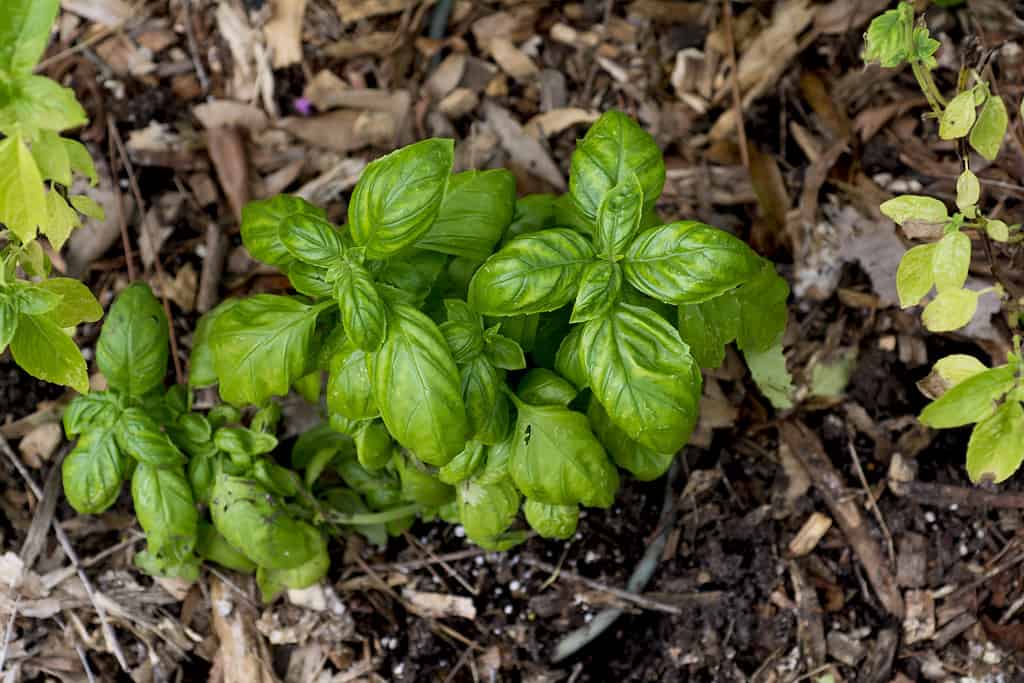
In addition to repelling flies, herbs like mint and rosemary have a rich culinary history, as they are used to enhance the flavors of various dishes.
©DIRDPKC/iStock / Getty Images Plus via Getty Images
5. Flypaper
Flypaper, also known as fly strips or fly ribbons, is a tried-and-true method for capturing and eliminating house flies. This traditional approach is simple, cost-effective, and highly efficient in reducing fly populations. Flypaper consists of long strips of paper coated with a sticky adhesive that lures flies and other flying insects.
The idea is straightforward: flies are attracted to the scent of the adhesive or to the visually appealing color of the paper, and when they land on the strip, they become stuck. Furthermore, the adhesive used on flypaper is non-drying, which means that it remains sticky for an extended period, allowing the flypaper to capture numerous flies. Once a fly becomes ensnared, it cannot escape, ultimately leading to its demise.
How to Use Flypaper to Control House Flies
Follow a few steps to use flypaper effectively:
- Identify areas in your home where flies are most active. Common spots include near windows, doors, and in the kitchen.
- Unroll the flypaper strip and hang it by its attached string or hook. Ensure that it is positioned horizontally and at a height where flies can easily access it.
- Regularly check the flypaper to gauge its effectiveness and see how many flies it has captured. Replace it when it’s covered with flies or is no longer sticky.
Flypaper is a cost-effective and environmentally friendly method for fly control. It is particularly useful in areas with high fly activity, such as during the warmer months or in kitchens and dining areas. Unfortunately, while flypaper is highly effective, it may not be the best choice if you have aesthetic concerns, as it is quite visible. However, you can strategically place it in less conspicuous areas to minimize its visual impact.
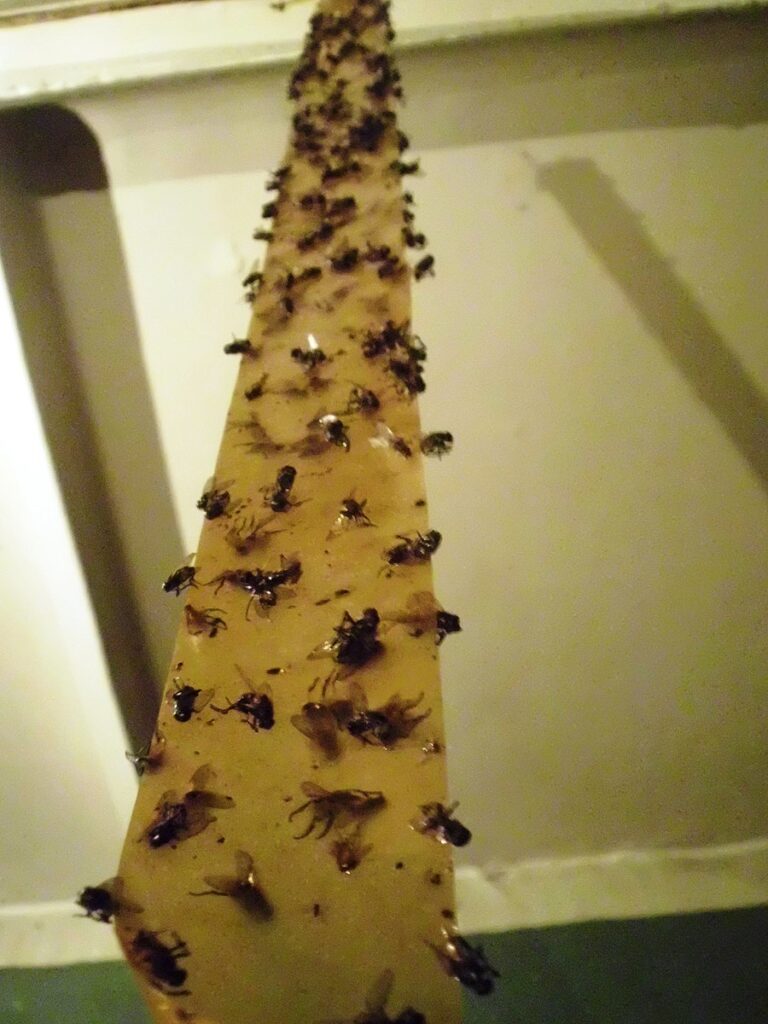
Flypaper consists of long strips of paper coated with a sticky adhesive that lures flies and other flying insects.
©Ural-66, CC BY-SA 4.0 <https://creativecommons.org/licenses/by-sa/4.0>, via Wikimedia Commons – Original / License
6. Electronic Fly Zapper
The electronic fly zapper is a contemporary and effective tool for swiftly dealing with house flies and other flying pests. These devices use advanced technology to attract, trap, and eliminate flies without the need for chemicals or manual intervention. Electric fly zappers, also known as electric fly killers or bug zappers, function through a combination of attractive features and electrocution.
Most electric fly zappers are equipped with UV light bulbs. These emit ultraviolet rays that attract flying insects, including house flies. Additionally, positioned near the UV light source is a grid or mesh made of electrically charged wires. Flies, drawn to the light, come into contact with this grid. When flies touch the electric grid, they complete an electrical circuit and receive an electric shock, which effectively eliminates them. Lastly, the zapper typically includes a removable collection tray at the bottom to catch the electrocuted flies and make cleanup easy.
How to Use an Electronic Fly Zapper to Control House Flies
Follow a few simple steps to get the most out of your zapper:
- Position the zapper in an area where flies are most active.
- Ensure that the zapper is connected to a power source and switched on. The UV light will attract flies into the device.
- Regularly check the zapper for captured flies.
- Empty the collection tray as needed to maintain the zapper’s efficiency.
Electronic fly zappers are highly effective at quickly eliminating flies, making them a popular choice for households and commercial settings. They are also ideal for dealing with a high volume of flies, such as during the summer or in areas with frequent outdoor access.
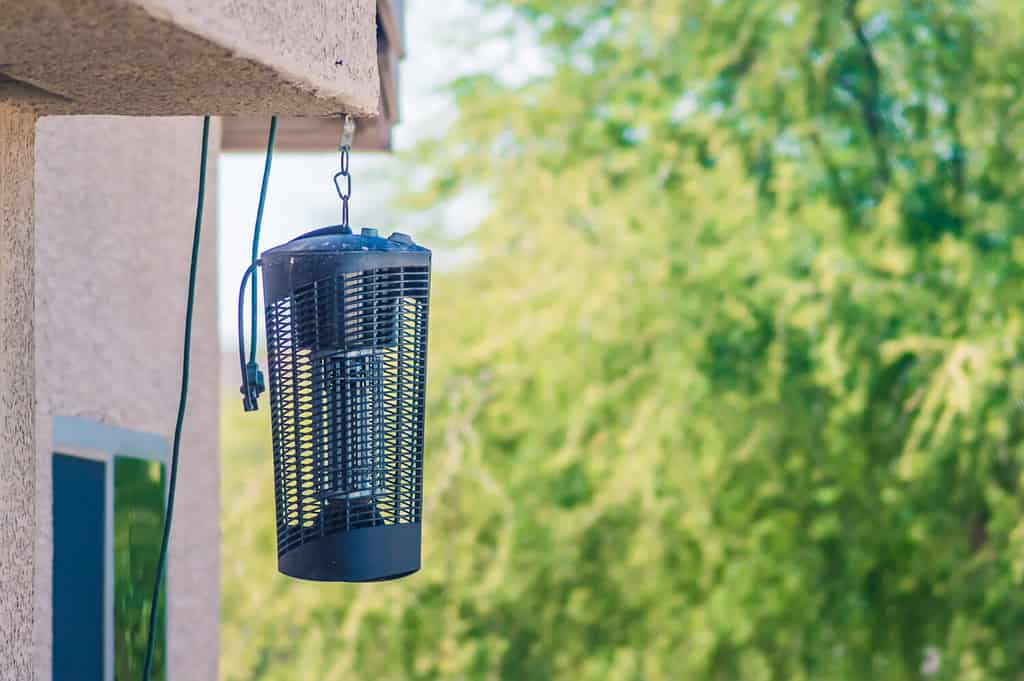
The first electric fly zapper was invented in 1911 by Samuel Crumbine, a public health advocate, as a more sanitary alternative to fly swatters.
©GreatSnapz/Shutterstock.com
Pine-Sol Spray
Pine-Sol is a popular cleaning product that also serves a dual purpose in your battle against house flies. Not only is it effective at cleaning and disinfecting your living space, but it also has a strong scent that can act as a natural fly repellent.
How to Use Pine-Sol to Control Flies
Pine-Sol for fly control is easy to use. Follow these steps:
- Mix Pine-Sol with water in a spray bottle. The recommended ratio is typically one part Pine-Sol to four parts water, but you can adjust the concentration as needed.
- Identify areas in your home where flies are most active.
- Spray the Pine-Sol solution on surfaces in these fly-prone areas. Common surfaces include countertops, floors, and around trash cans.
- Reapply the solution as needed, especially after cleaning or if the scent begins to fade.
Pine-Sol is made from pine oil, a natural ingredient, and is generally safe for use around humans and pets when used as directed. It is also effective in repelling flies thanks to its strong, pine-scented odor. However, it may not be as potent as some other fly-repellent methods, and its effectiveness varies depending on factors such as the concentration of the solution, the room’s ventilation, and the number of flies in the area.
How to Prevent House Flies in Your Home
Preventing flies from infesting your home is a proactive and effective approach to maintaining a clean and hygienic living environment. Here are some strategies to prevent flies:
- Maintain cleanliness: Regularly clean your home and empty trash cans with tightly fitting lids.
- Store food properly: Store food in airtight containers and keep fruits and vegetables covered.
- Screens and sealing: Install screens on doors and windows and seal cracks and gaps.
- Waste management: Properly manage compost piles and maintain clean, sealed outdoor trash cans.
- Professional pest control: Consider hiring professionals for severe fly infestations.
- Landscape maintenance: Keep areas dry, clean, and free of debris to deter flies.
- Pet hygiene: Promptly clean up pet waste and dispose of it properly.
Keeping Flies Away Naturally
House flies are not only a nuisance but also pose health risks. Thankfully, there are natural and effective ways to get rid of them and prevent infestations. From homemade fly traps that capture flies without the use of chemicals to essential oils and herbs that repel these pests with their natural scents, there are numerous options to choose from.
However, it is important to remember that the effectiveness of these methods varies depending on the severity of your infestation and specific circumstances in your home. Often, a combination of these natural approaches is the most effective way to ensure a fly-free environment.
| Number | Natural Method | Infestation Size |
|---|---|---|
| 1 | Homemade Fly Traps | Small to moderate |
| 2 | Essential Oils | Small to moderate |
| 3 | Citronella Candles | Small to moderate |
| 4 | Herbs | Small to moderate |
| 5 | Flypaper | Moderate to large |
| 6 | Electronic Fly Zapper | Moderate to large |
Thank you for reading! Have some feedback for us? Contact the AZ Animals editorial team.

